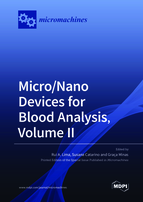Micro/Nano Devices for Blood Analysis, Volume II
A special issue of Micromachines (ISSN 2072-666X). This special issue belongs to the section "B:Biology and Biomedicine".
Deadline for manuscript submissions: closed (15 November 2021) | Viewed by 42107
Special Issue Editors
Interests: microfluidics; nanofluids; bio-microfluidics; heat transfer
Special Issues, Collections and Topics in MDPI journals
Interests: lab-on-a-chip; organ-on-a-chip; microsensors and microactuators
Special Issues, Collections and Topics in MDPI journals
Interests: lab-on-a-chip; microfluidics; microdevices; sensors and actuators
Special Issues, Collections and Topics in MDPI journals
Special Issue Information
Dear Colleagues,
The development of micro- and nanodevices for blood analysis is an interdisciplinary subject that demands an integration of several research fields, such as biotechnology, medicine, chemistry, informatics, optics, electronics, mechanics, and micro/nanotechnologies.
Over the last few decades, there has been a notably fast development in the miniaturization of mechanical microdevices, later known as microelectromechanical systems (MEMS), which combine electrical and mechanical components at a microscale level. The integration of microflow and optical components in MEMS microdevices, as well as the development of micropumps and microvalves, have promoted the interest of several research fields dealing with fluid flow and transport phenomena happening at microscale devices. Microfluidic systems have many advantages over macroscale by offering the ability to work with small sample volumes, providing good manipulation and control of samples, decreasing reaction times, and allowing parallel operations in one single step. As a consequence, microdevices offer a great potential to develop portable and point-of-care diagnostic devices, particularly for blood analysis. Moreover, the recent progress of nanotechnology is gaining popularity and has expanded the areas of application of the microfluidic devices, including the manipulation and analysis of flows on the scale of DNA, proteins, and nanoparticles (nanoflows).
In this Special Issue, we invite contributions (original research papers, review articles, and brief communications) that focus on the latest advances and challenges in micro- and nanodevices for diagnostics and blood analysis, micro- and nanofluidics, technologies for flow visualization, MEMS, and biochips and lab-on-a-chip devices and their application to research and industry. We hope to provide an opportunity to the engineering and biomedical community to exchange knowledge and information and bring together researchers who are interested in the general field of MEMS and micro/nanofluidics, especially in its applications to biomedical areas.
Dr. Rui A. Lima
Prof. Graça Minas
Dr. Susana Catarino
Guest Editors
Manuscript Submission Information
Manuscripts should be submitted online at www.mdpi.com by registering and logging in to this website. Once you are registered, click here to go to the submission form. Manuscripts can be submitted until the deadline. All submissions that pass pre-check are peer-reviewed. Accepted papers will be published continuously in the journal (as soon as accepted) and will be listed together on the special issue website. Research articles, review articles as well as short communications are invited. For planned papers, a title and short abstract (about 100 words) can be sent to the Editorial Office for announcement on this website.
Submitted manuscripts should not have been published previously, nor be under consideration for publication elsewhere (except conference proceedings papers). All manuscripts are thoroughly refereed through a single-blind peer-review process. A guide for authors and other relevant information for submission of manuscripts is available on the Instructions for Authors page. Micromachines is an international peer-reviewed open access monthly journal published by MDPI.
Please visit the Instructions for Authors page before submitting a manuscript. The Article Processing Charge (APC) for publication in this open access journal is 2600 CHF (Swiss Francs). Submitted papers should be well formatted and use good English. Authors may use MDPI's English editing service prior to publication or during author revisions.
Keywords
- microfluidics
- nanofluidics
- MEMS
- biomedical microdevices
- micro/nano fabrication
- blood flow
- blood-on-chips
- blood cells
- biomicrofluidics
- nanoparticles
- blood analysis
- point-of-care
- spectrophotometry









